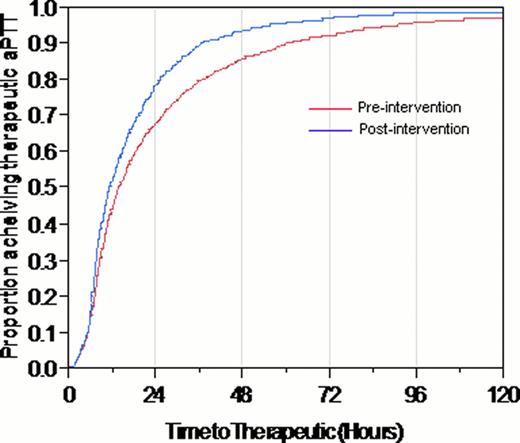Abstract
Abstract 1168
Continuous infusions of unfractionated heparin (UFH) are still commonly used in the initial treatment of venous thromboembolism (VTE). As a result of UFH's high risk profile and common usage, weight-based UFH nomograms were developed more than two decades ago to standardize its dosing. Since that time, there has been scant literature on improving UFH administration. Specifically, upgrading current UFH nomograms, improving therapeutic monitoring, and exploring and expanding the role of Computerized Physician Order Entry (CPOE) and the Electronic Health Record (EHR) to achieve optimal delivery methods have little published research or quality improvement work.
Several factors previously identified contributing to sub-optimal UFH therapy at our institution include timing of aPTT lab ordering and reporting, errors in dose adjustments, lack of boluses when clinically indicated, pharmacy and nursing administration errors, and suboptimal design and use of CPOE order sets.
A multidisciplinary team at this academic medical center designed an intervention to improve the quality and safety of continuous UFH infusions in hospitalized patients. The aims were two-fold: reduce the time to initial therapeutic aPTT values and increase the overall time patients spent in therapeutic range without increasing time supra-therapeutic. To determine the percent time spent in different therapeutic ranges, linear averaging was used between aPTT values over time. As UFH is given continuously and monitoring aPTT values has inherent variability, we proposed that looking at time spent in therapeutic ranges gives a more realistic and meaningful clinical picture than current accepted metrics that look at single point-in-time aPTT values. We feel that these historic metrics, which focus on the percentage of patients with a therapeutic aPTT at 24 hours and time to therapeutic aPTT, do not provide sufficient information to impact optimal therapeutic dosing.
The intervention involved four core changes to our existing UFH nomogram:
Dedicated UFH order set for treatment of VTE incorporating weight-based initial and subsequent boluses, and further dosage adjustments.
Built-in online weight-based dosing calculator.
Development of a new lab order aPTTAC (activated partial thromboplastin time anticoagulant) which prompted a priority lab draw and lab processing.
Nursing dual sign-off on all dosage adjustments.
We extracted data from the EHR of 8629 patients that were on continuous infusion UFH for VTE from January 2010 through February 2012. There were 5759 patients in the pre-intervention group and 2870 patients in the post-intervention group. All patients on therapy for greater than 8 hours who had at least one aPTT were included in the analysis.
Post-intervention, the proportion of patients who were therapeutic within 24 hours increased 16% (67% to 78%, p value <0.0001), and time to therapeutic aPTT decreased by 18% (13.9 hours to 11.4 hours, p value <0.0001). (Figure 1)
Additionally, post-intervention, the proportion of time spent inside the therapeutic range increased from 47% to 53% (p value <0.0001). There was a small increase in percentage time supra-therapeutic from 20% to 21%, (p value <0.0001), however, this was not associated with increased bleeding events.
Safety analysis, which involved the manual review of 131 pre-intervention and 127 post-intervention charts revealed a trend towards lower bleeding rates with the new UFH nomogram. The rate of major bleeding was 3.9% post intervention compared to 6.9% before the upgrade (p value 0.4116).
This safety initiative demonstrates a significant improvement in the safe and effective use of continuous UFH infusion in the treatment of VTE. Through creative utilization of technology and improved process of care we have brought high reliability to this high-risk medication. To our knowledge, this is the largest cohort of patients evaluated for safe VTE treatment with a UFH nomogram. Further retrospective analysis of this data evaluating patient specific characteristics should shed light on opportunities to improve the UFH nomogram and further leverage the EHR and CPOE to improve patient care. While our evaluation looks at a single center, these interventions could easily be implemented in other hospital systems with EHR and CPOE capabilities.
No relevant conflicts of interest to declare.
Author notes
Asterisk with author names denotes non-ASH members.


This feature is available to Subscribers Only
Sign In or Create an Account Close Modal